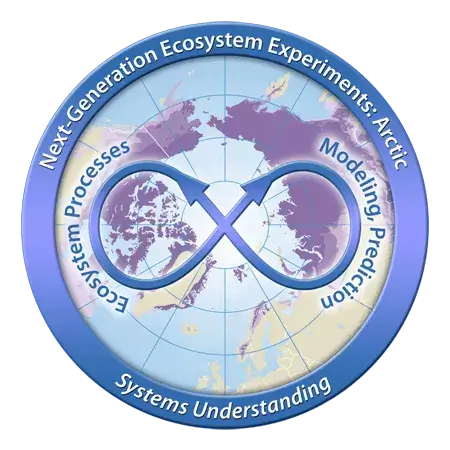2022
- Farquharson, Louise M., et al. “Sub-Aerial Talik Formation Observed across the Discontinuous Permafrost Zone of Alaska”. Nature Geoscience, vol. 15, no. 6, 2022, pp. 475-81, https://doi.org/10.1038/s41561-022-00952-z.
2021
- Mekonnen, Zelalem A., et al. “Changes in Precipitation and Air Temperature Contribute Comparably to Permafrost Degradation in a Warmer Climate”. Environmental Research Letters, vol. 16, no. 2, 2021, p. 024008, https://doi.org/10.1088/1748-9326/abc444.
- Schneider von Deimling, Thomas, et al. “Consequences of Permafrost Degradation for Arctic Infrastructure – Bridging the Model Gap Between Regional and Engineering Scales”. The Cryosphere, vol. 15, no. 5, 2021, pp. 2451-7, https://doi.org/10.5194/tc-15-2451-2021.
- Debolskiy, Matvey V., et al. “Water Balance Response of Permafrost-Affected Watersheds to Changes in Air Temperatures”. Environmental Research Letters, vol. 16, no. 8, 2021, p. 084054, https://doi.org/10.1088/1748-9326/ac12f3.
2020
- Euskirchen, Eugénie S., et al. “Co‐producing Knowledge: The Integrated Ecosystem Model for Resource Management in Arctic Alaska”. Frontiers in Ecology and the Environment, vol. 18, no. 1, 2020, pp. 447-55, https://doi.org/10.1002/fee.2176.
- Debolskiy, Matvey V., et al. “Modeling Present and Future Permafrost Distribution at the Seward Peninsula, Alaska”. Journal of Geophysical Research: Earth Surface, vol. 125, no. 8, 2020, https://doi.org/10.1029/2019JF005355.
- Andersen, Jeremiah K., et al. “The State of the Climate in 2019: The Arctic”. Bulletin of the American Meteorological Society, vol. 101, no. 8, 2020, pp. S239 - S286, https://doi.org/10.1175/BAMS-D-20-0086.1.
2019
- Léger, Emmanuel, et al. “A Distributed Temperature Profiling Method for Assessing Spatial Variability in Ground Temperatures in a Discontinuous Permafrost Region of Alaska”. The Cryosphere, vol. 13, 2019, pp. 2853-67, https://doi.org/10.5194/tc-13-2853-2019.
- Garayshin, V.V., et al. “Numerical Modeling of Two-Dimensional Temperature Field Dynamics across Non-Deforming Ice-Wedge Polygons”. Cold Regions Science and Technology, vol. 161, 2019, pp. 115-28, https://doi.org/10.1016/j.coldregions.2018.12.004.
2018
- Wang, Kang, et al. “A Synthesis Dataset of Permafrost-Affected Soil Thermal Conditions for Alaska, USA”. Earth System Science Data, vol. 10, no. 4, 2018, pp. 2311-28, https://doi.org/10.5194/essd-10-2311-2018.
- Parazoo, Nicholas C., et al. “Detecting the Permafrost Carbon Feedback: Talik Formation and Increased Cold-Seasonrespiration As Precursors to Sink-to-Source Transitions”. The Cryosphere Discussions, 2018, pp. 1-44, https://doi.org/10.5194/tc-2017-18910.5194/tc-2017-189-RC110.5194/tc-2017-189-RC210.5194/tc-2017-189-AC110.5194/tc-2017-189-AC2.
- Bisht, Gautam, et al. “Impacts of Microtopographic Snow Redistribution and Lateral Subsurface Processes on Hydrologic and Thermal States in an Arctic Polygonal Ground Ecosystem: A Case Study Using ELM-3D v1.0”. Geoscientific Model Development, vol. 11, no. 1, 2018, pp. 61-76, https://doi.org/https://doi.org/10.5194/gmd-11-61-2018.
- Nicolsky, Dmitry J., and Vladimir E. Romanovsky. “Modeling Long-Term Permafrost Degradation”. Journal of Geophysical Research: Earth Surface, vol. 123, no. 8, 2018, pp. 1756-71, https://doi.org/10.1029/2018JF004655.
- Jafarov, Elchin E., et al. “Modeling the Role of Preferential Snow Accumulation in through Talik Development and Hillslope Groundwater Flow in a Transitional Permafrost Landscape”. Environmental Research Letters, vol. 13, no. 10, 2018, p. 105006, https://doi.org/10.1088/1748-9326/aadd30.
2017
- Nicolsky, Dmitry J., et al. “Applicability of the Ecosystem Type Approach to Model Permafrost Dynamics across the Alaska North Slope”. Journal of Geophysical Research: Earth Surface, vol. 122, no. 1, 2017, pp. 50-75, https://doi.org/10.1002/2016JF003852.
- Dafflon, Baptiste, et al. “Coincident Aboveground and Belowground Autonomous Monitoring to Quantify Covariability in Permafrost, Soil, and Vegetation Properties in Arctic Tundra”. Journal of Geophysical Research: Biogeosciences, vol. 122, no. 6, 2017, pp. 1321-42, https://doi.org/10.1002/2016JG003724.
- Wang, Kang, et al. “Continuously Amplified Warming in the Alaskan Arctic: Implications for Estimating Global Warming Hiatus”. Geophysical Research Letters, vol. 44, no. 17, 2017, pp. 9029-38, https://doi.org/10.1002/2017GL074232.
- Strauss, Jens, et al. “Deep Yedoma Permafrost: A Synthesis of Depositional Characteristics and Carbon Vulnerability”. Earth-Science Reviews, vol. 172, 2017, pp. 75-86, https://doi.org/10.1016/j.earscirev.2017.07.007.
- Raz-Yaseef, Naama, et al. “Large Carbon Dioxide and Methane Emissions from Polygonal Tundra During Spring Thaw in Northern Alaska”. Geophysical Research Letters, vol. 44, no. 1, 2017, pp. 504-13, https://doi.org/10.1002/2016GL071220.
2016
- Olefeldt, David, et al. “Circumpolar Distribution and Carbon Storage of Thermokarst Landscapes”. Nature Communications, vol. 7, 2016, p. 13043, https://doi.org/10.1038/ncomms13043.
- Harp, Dylan R., et al. “Effect of Soil Property Uncertainties on Permafrost Thaw Projections: A Calibration-Constrained Analysis”. The Cryosphere, vol. 10, no. 1, 2016, pp. 341-58, https://doi.org/10.5194/tc-10-341-201610.5194/tc-10-341-2016-supplement.
- Kumar, Jitendra, et al. “Modeling the Spatiotemporal Variability in Subsurface Thermal Regimes across a Low-Relief Polygonal Tundra Landscape”. The Cryosphere, vol. 10, no. 5, 2016, pp. 2241-74, https://doi.org/10.5194/tc-10-2241-2016.
- Liljedahl, Anna K., et al. “Pan-Arctic Ice-Wedge Degradation in Warming Permafrost and Its Influence on Tundra Hydrology”. Nature Geoscience, 2016, https://doi.org/10.1038/ngeo2674.
- Cable, William L., et al. “Scaling-up Permafrost Thermal Measurements in Western Alaska Using an Ecotype Approach”. The Cryosphere, vol. 10, no. 5, 2016, pp. 2517-32, https://doi.org/10.5194/tc-10-2517-2016.
- Farquharson, Louise M., et al. “Spatial Distribution of Thermokarst Terrain in Arctic Alaska”. Geomorphology, vol. 273, 2016, pp. 116-33, https://doi.org/10.1016/j.geomorph.2016.08.007.
2015
- Koven, Charles D., et al. “A Simplified, Data-Constrained Approach to Estimate the Permafrost carbon–climate Feedback”. Philosophical Transactions of the Royal Society A: Mathematical, Physical and Engineering Sciences, vol. 373, no. 2054, 2015, https://doi.org/10.1098/rsta.2014.0423.
- Muskett, Reginald R., et al. “Active-Layer Soil Moisture Content Regional Variations in Alaska and Russia by Ground-Based and Satellite-Based Methods, 2002 through 2014”. International Journal of Geosciences, vol. 06, no. 01, 2015, pp. 12-41, https://doi.org/10.4236/ijg.2015.61002.
- Schuur, Edward A.G., et al. “Climate Change and the Permafrost Carbon Feedback”. Nature, vol. 520, no. 7546, 2015, pp. 171-9, https://doi.org/10.1038/nature14338.
- Heikoop, Jeffrey Martin, et al. “Isotopic Identification of Soil and Permafrost Nitrate Sources in an Arctic Tundra Ecosystem”. Journal of Geophysical Research: Biogeosciences, vol. 120, no. 6, 2015, pp. 1000-17, https://doi.org/10.1002/2014JG002883.
- Lara, Mark J., et al. “Polygonal Tundra Geomorphological Change in Response to Warming Alters Future CO2 and CH4 Flux on the Barrow Peninsula”. Global Change Biology, vol. 21, no. 4, 2015, pp. 1634-51, https://doi.org/10.1111/gcb.12757.Details
- Atchley, Adam L., et al. “Using Field Observations to Inform Thermal Hydrology Models of Permafrost Dynamics With ATS (v0.83)”. Geoscientific Model Development, vol. 8, no. 9, 2015, pp. 2701-22, https://doi.org/10.5194/gmd-8-2701-2015.

